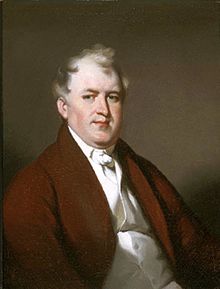Nathan Dunn

Nathan Dunn (1782 in Salem County, New Jersey – 1844 in Switzerland) was an American businessman and philanthropist notable for his vast collection of Chinese artifacts of significant educational value. It was displayed as Chinese Museum in Philadelphia in 1838, and in London in 1842 and 1851, where it was auctioned, finding its way to British artists and designers eager to employ new ideas.
Biography
Nathan Dunn was one of 5 children in the farming family of Nathan Dunn and Rhoda, née Silvers.[1] His father died in 1782 at the age of 39. In 1788 Rhoda married Thomas Osborn and had 3 more children, of them Rhoda Osborn married Restore S. Lamb. Rhoda and Restore S. Lamb were noted ministers of the Religious Society of Friends.[2]
In 1816, Nathan Dunn was disowned by Philadelphia Monthly Meeting of the Society of Friends for bankruptcy. However, John Field, one of his creditors, decided that the way to return his money was to create a joint business, posting N. Dunn in China.[3]
In 1818 N. Dunn went to Canton, China (Guangzhou in Mandarin), buying tea and fabrics, selling specially produced British goods, and strictly abstaining from opium trade, common profitable business of the time. Compliance with the Chinese anti-opium laws was one of those things that created for him a good reputation among his Chinese partners. He returned to Philadelphia in 1832, bringing with him a large collection of Chinese artistic and cultural objects and paid off all of his creditors.
Philadelphia Museum Company, formerly the museum of Charles Willson Peale, appointed Dunn to its board of directors in 1836. He invested in the new museum building and as a result for a limited time he was free to use the first floor of the building for his own museum.

In 1838, he opened the “Chinese Museum” in Philadelphia, with an accompanying 120-page catalog, Ten Thousand Chinese Things. 100,000 visitors saw it in Philadelphia and an equal number in London, where the Collection was displayed in a pagoda-like exhibition hall at Hyde Park Corner in 1842. 70,000 to 80,000 catalogs were sold in the U.S. and England.
Apart from artifacts, the museum had life-size clay figures accurately modeled after about 50 real Chinese acquaintances personally selected by N. Dunn, representing variety of social positions, occupations etc., standing against dioramas, and extensive annotations of the exhibits.
Nathan Dunn was a supporter of several charities, specifically, in 1840 he gave a gift of over $20,000 Haverford College. He built a "cottage" in Mt. Holly, N.J., which for many years was run by his half-sisters Phoebe and Rhoda.
Dunn in 1844 in Vevay Switzerland. His remains were returned to the US and he was interred at Laurel Hill Cemetery in Philadelphia.[4] His partners brought his Chinese Collection to London once again in 1851, to coincide with the Great International Exhibition. This time the collection was largely ignored, and much of it was auctioned at Christie’s in December of that year. The auction opened a new chapter in the story of Asian influence in British art. A third of the objects were bought by one London dealer, and through his shop the remnants of the Collection were disseminated to young British artists and designers ready to transfer global discoveries into modern design.
Links
- Peter C. Perdue. Canton and Hongkong // MIT Visualizing Cultures
- "Dwarf Trees" from Nathan Dunn's Chinese Collection
- Victorian London - Entertainment and Recreation - Museums, Public Buildings and Galleries - The Chinese Collection / Chinese Exhibition
- Description of the exhibition, in The Asiatic Journal and Monthly Register for British India and Its Dependencies: Volume 39 (1842), pp. 341–42.[5]
Literature
- Nathan Dunn in Dictionary of Quaker Biography
- Arthur W. Hummel, "Nathan Dunn," Quaker History, 59 (1970), p. 34-39
- Leah Blackman. History of Little Egg Harbor Township, Burlington County, N.J., from its first settlement to the present time.
- Nancy B. Wilkinson. The Chinese Collection of Nathan Dunn: Its Origin, Travels and Influence on the Arts of Britain/ International Journal of the Arts in Society, Volume 3, Issue 4, pp. 61–70.
- John Haddad. "China in Miniature: Nathan Dunn’s Chinese Museum," Romance of China: Excursions to China in US Culture, 1776-1876.
References
- ^ "Ancestry.com - Salem Monthly Meeting Births and Deaths, 1686-1798, p. 113". Retrieved 2020-07-29.
- ^ "Haverford College - Quaker and Special Collections - Dunn and Osborn families". Archived from the original on 2012-05-18. Retrieved 2013-04-07.
- ^ John Rogers Haddad. The Romance of China: U. S. Excursions... // 4. China in Miniature: Nathan Dunn’s Chinese Museum
- ^ Smith, R.A. (1852). Smith's Illustrated Guide to and through Laurel Hill Cemetery. Philadelphia: Willis P. Hazard. p. 77. Retrieved 30 June 2020.
- ^ https://play.google.com/books/reader?id=VDs9AQAAMAAJ&printsec=frontcover&output=reader&hl=en_GB&pg=GBS.PA341
